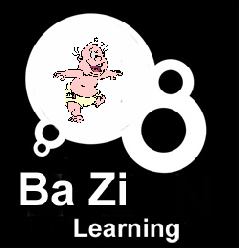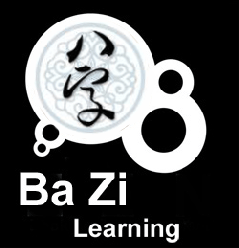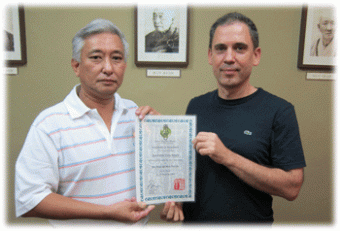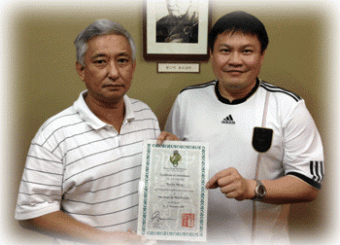
Speaker Yit Meng From China
Hello Teacher Leyau, and all gracious guests, a good day to everybody!
I am from China, and one of the students of our great teacher, Master Leyau. I am honoured to be able to attend this convention. Today, my presentation topic is “an introduction to ancient feng shui studies in China, and its progress in modern times”. I welcome your feedback!
In the long ancient past of China, Feng Shui was given a high status in society. Feng Shui theory and philosophy was called “Imperial Study”. It has been passed down for thousands of years in China, and it is full of precious and useful practical value.
According to many archaeological finds, as early as 6000 to 7000 years ago, the ancient Chinese people had already reached a high level in their selection and knowledge of the living environment. In the Neolithic period in China (5000-3000 bc) of Yan Shao, the living premises of that Yan Shao period has displayed a very obvious tendency of “environmental selection” like for example:
(1) proximity to source of water for water consumption purpose as well as for agriculture
(2) at the cross-roads of water ways, to facilitate transport
(3) locate at the river delta area, where there is fertile soil for agriculture and prevention from severe flooding
(4) if on a hill, tend to be on the yang side slope.
Example: Ban Po site (ancient Neolithic site) is described as leaning on a hill with water at its side, the meeting point of two cradling water ways – an excellent feng shui set up

半坡陶器 Ban Po ceramic
Ban Po archaeological site is located in China’s Jia Xi province, the city of Xi An’s eastern suburb. It is a classic example of an prehistoric village in the Yellow River (Huang He) basin area of a matriarchal tribe of people. It belongs to the New stone age period of the Neolithic culture, about 600 years ago. It was discovered in 1952, excavated during 1954-1957, Ban Po site is China’s first big scale excavation of a new stone age village commune site, and in 1957 was designated as a museum.
 西安半坡博物館
西安半坡博物館
Xi An Ban Po Museum
As you can see, the ancient people were very particular about choosing a site for settling down and this ancient tradition remained deeply entrenched in the minds of the later people, manifesting itself in the way many modern cities, towns and villages are located and built. In summary, human beings during the survey of environment, has already started to consciously choose sites for their environments.
 世界文化遺產—安陽殷墟
世界文化遺產—安陽殷墟
World cultural heritage – An Xi Yin Burial Grounds
From the ruins of the Yin Shang palace, we can clearly see that the level of understanding of the influence that a river has on a living environment has reached a high level. At today’s Henan An Yang, about 2 kilometres north west is a small village that was the capital of the Yin Shang Dynasty.
The waters of the Huan river flow from North West to South, before turning to the East. On the two sides of this river, at small village area of the south bend is the location of the Shang dynasty palace grounds; on the palace’s west, north, south east and the east of the Huan river are where the common people and middle and lower nobles live, work and their cemeteries, etc. On the northern side where the higher status noble families and the government and military village are located, it is the Shang Emperor and nobility’s imperial tombs zone
What needs to be strongly emphasized is, no matter if it is the palace grounds area, the common people living area, or the production area and imperial tomb area, they were all located within the convoluted cradling water ways. This proves sufficiently the later feng shui studies’ pursuit of the concept of “cradling is precious and auspicious”.
Just like what Jiang Ping Jie’s Water Dragon Classic said: “Natural water method, gentlemen please remember, there is nothing than meanders (water flow) that have feelings, incoming should not be rushing and outgoing should not be straight, horizontal should be embracing and meandering.” “when the waters ways have 3 meanders, good fortune, longevity and peace, when the incoming is meandering, prosperity and high position surrounds”.
Further to that, in feng shui studies, within the river curve is considered auspicious grounds while outside of the river curve is considered bad area. The classic “Kan Yu Xie Mi” mentions: “when the water embrace we can still look for sites, when the water is on the opposing side, do not look”. The Water Dragon Classic thinks that “reverse flight water”, “reverse jump water”, “double oppose water”, “reverse bow water” types of land formations are all considered bad areas and not suitable for keeping livestock and living. As the poem goes, “for the water to be sentimental (auspicious), favour a loop back to the auspicious site. The pulse of the water and dragon should not be clashed back.”

安陽殷墟
An Yang Burial Grounds
Chinese Feng Shui studies emphasize that city and construction should be “facing south towards yang”, this actually carries a strong and deep cultural background, and has very rational scientific evidence. From the cultural point of view, this has close relationship with the Zhou Yi.
“Zhou Yi, Discuss Trigram” mentions: “The holy persona faces south and listens to the world”. People regard the emperor’s strategy of controlling the country as “art of facing south” originates from that quote. Besides, the Chinese astronomy chart is based on the facing south to look at the sky, maps are made based on facing south looking down.
That is why the Chinese ancient way of looking at directions is very special: front south back north, left east and right west, while the modern people of today commonly use the western method of looking at directions (top north down south left west and right east) is directly opposite.
The origins of the idea of “face South towards Yang”, is due to the special circumstances in the environment. This is because China is located on the North hemisphere, where the sunlight is most of the time coming from the southern side. People’s lives and productivity have first priority on receiving direct sunlight, and this decided the people’s choice of light must be from South then.
Also, the choice of facing south for living is also related to the seasonal winds. In large areas of China during winter, the cold winds are the northern winds, while the warm and moist winds in summer are the southern winds, and this decided Chinese Feng Shui’s environmental model should be sit North face South, while West, North and East 3 sides have cradling mountains, to block the cold winter seasonal winds; south side open and broad to welcome the warm and moist summer wind.
Because of “face south for living”, in feng shui, we use the Green Dragon, White Tiger, Vermillion Phoenix and Xuan Wu (black Tortoise) to represent sectors, just like what is mentioned in the feng shui classic (Book of Burials) that said:
“Left is Green dragon Qing Long
Right is White Tiger Bai Hu
Front is Vermillion phoenix Zu Que
Back is Black Tortoise Xuan Wu”
“In the feng shui classic , “Ten books on Yang premises” it is mentioned:
“When the premises has flowing water on the left, that is the Green Dragon,
Right has a long path, it is the White Tiger,
Front has pond (usually crescent moon shape), it is the Vermillion Phoenix,
Back has a hill, it is the Black Tortoise,
This will be a precious feng shui ground”.
And hence, the Green Dragon, White Tiger, Vermillion Phoenix and Black Tortoise became feng shui technical terms for the 4 sectors.
We do not know when did these 4 animals became used as the feng shui technical term for the 4 sectors. However, in Henan, Xi Shui Bo, at an archaeological excavation of a Yin Shang period burial ground that is 6000 years old, there is picture that clearly shows the use of shells to make up the shapes of the “Green Dragon” and “White Tiger” figures that are placed by the side of the skeleton. If in that grave the “Green Dragon” and “White Tiger” shapes are used to indicate sectors/directions, then the later feng shui’s written works’ “Green Dragon meander, White Tiger squatting” idea can be traced back to 6000 years ago to the Yin Shang period

仰韶文化墓葬“青龍”“白虎”圖形
Yin Shang period grave “Green Dragon” and “White Tiger” shapes
During May 1987 to September 1988. In China’s Henan Pu Yan County, to the south west Xi Shui Bo Bo, 3 sets of shell dragon and tiger figures from the Yin Shang period was excavated. The first set at No.45 grave site, there is a skeleton of a male, height 1.84 m, lying flat, with head to the south and feet to the north.
On the right there is a dragon shaped from shell, with head to North, facing East, with head raised and back arched, tail in waving shape, like wandering through the ocean.
On the right there is a tiger shaped from shells, head to North and facing West, with a fierce looking stature, baring its teeth, like a tiger descending a mountain.
This tomb’s formation coincide with the ancient astronomy’s 4 celestial creature’s East palace dragon and west palace tiger.
From the past until present, in countries with some kind of history, there are always grand palaces, but with the passage of time, those imperial palaces that have been kept in their pristine condition are few. The only exception is the Beijing Gu Gong (Forbidden City) that is the world’s only better preserved palace. That is why international architects like to conduct research on the Forbidden City, and agree unanimously that the Forbidden City is one of the world’s best feng shui precious site. When we talk about feng shui, it is unavoidable to mention the Forbidden City.
 故宮
故宮
Forbidden City
The Forbidden City began construction is 1406 and was completed in 1420, and the first emperor to order its construction is Emperor Zhu Di of the Ming dynasty. The Forbidden City’s is 961 meters south to north, 753 meters east to west, and covers an area of 723600 meters square, with built up area of 155 000 square meters.
The Forbidden City has 4 entrances, with the main entrance named as the Wu Men (Wu Door), East entrance is named Dong Hua Men (East Magnificent Door) , West entrance is named as Xi Hua Men (East Magnificent Door) and North entrance is named Shen Wu Men (Great Conquering General Door)
Facing the North Entrance Shen Wu Men, there is man-made Jing Shan (beautiful hill) made from earth and stones, and is covered with evergreen forest. Looking as a whole, the Jing Shan can be said to be the Forbidden City’s protective barrier.
The palatial buildings in the Forbidden City is aligned on the south-north axis, with the 3 great halls (Tai He Dian, Zhong He Dian, Pau He Dian), 3 back palaces (Qian Qing Gong, Jiao Tai Dian, Kun Ning Gong) and imperial gardens all on the middle south-north axis, expanding to both sides, south and north in a straight line, left and right symmetrical.
The Forbidden City was designed by the feng shui/geography grand master Liao Jun Qing. Liao Jun Qing in his memorial self-proclaimed “official lineage of grand master Yang” because his ancestor Liao Shan Chuan from the Tang dynasty had lineage from the great feng shui grandmaster Yang Yun Song. As the master builder for the Forbidden City, he implemented the feng shui method of Yang Gong for the Forbidden City.
In the 18th year of Emperor Yong Le’s reign, which is period 6, the Forbidden City’s axis is sitting Zi (Rat) and facing Qu (Horse), that matches exactly to the feng shui classic “the 48 formations of the Qing Nang Satchel” (Qing Nang Si Shi Ba Ju)’s number 29th formation. In the feng shui classic “Heaven Jade Classic” (Tian Yu Jing), it is mentioned:
“Kun mountain, Kun Facing, Water flows Kun,
Never ending prosperity and nobility”
Which refers to this kind of feng shui formation.
Through his family’s lineage, Liao Jun Qing received the secrets of Grandmaster Yang’s feng shui. He cleverly used the:
“River East one family, River West one family and South-North one family” to form the
Fu Mu San Ban Gua (Father and Mother 3 Classes of Trigrams) theory
on the Dragon, Water, Sitting and Facing combination,
sitting and facing location,
Cui Guan (Expedite power),
Cui Cai (Expedite Wealth) and the
“one hexagram two uses” technique
To exquisitely choose the period for space and timing and to avoid the imprisonment, and the
“7 Stars Robbery technique”
What a brilliant crystallization of the great Chinese Feng Shui Principles!
From Forbidden City’s macro-view of the feng shui formation, to the minor details in decorations, the feng shui ideas are everywhere. It is a perfect model and example for Feng Shui studies.
However, for the past few decades, due to the limit on social and scientific developments, the present practitioners of feng shui are still not able to use a scientific technique for a complete proof. As such, the study of Feng Shui in China went through a long period of time when it was neglected, even abandoned.
It was until 10th of August, 2005, when the Chinese Architecture Cultural Centre passed a document (2005)77 named “Notice to establish Chinese Architecture Cultural Centre Architectural Feng Shui Cultural Committee”, that China established an official government research agency on Feng Shui. The professional committee comprises on famous feng shui writers and practitioners.
The document acknowledged again that Feng Shui is an important component of China’s Traditional architecture and has considerable value to the modern cyclical economy and sustainable development; and started the training and information services for architectural Feng Shui. The China Architectural Society’s online journal published essays on feng shui, to provide guidance on discussion of Feng Shui theories.
In the same year, in an interview with the media with the China Ministry of Construction, on the China Network Television (CCTV)’s morning news programmed “Respect for Feng Shui Research”, the ministry expressed its attitude towards Feng Shui. Since 2005 until now, in Beijing and Nanjing conducted a series of 5 seminars
Up until 2005 before China established its government research agency (China Architecture Feng Shui Professional Committee), government officials have never explored deeply into this aspect. This resulted in an academic gap in the origin of feng shui theory, history, purpose, meaning as well as its value and influence on China’s ancient architecture practice and theory.
What was once regarded as superstition from the feudal period, China’s ancient Feng Shui study has now become an inseparable part of Chinese studies, and has eventually received increasing attention of contemporary scholars.
In the world of the Chinese academia, the number of research treatise on ancient Feng Shui study, can be said to be like a hundred flowers blooming. Some of the theories in Feng Shui studies were also used by the the Qing Hua University and Beijing University and various other institutions of higher learning in their architectural and environmental design.
The modern learners consider that: the traditional culture of Chinese Feng Shui is a strong, comprehensive and systematic theory of ancient architecture planning. The essence of Feng Shui is in being able to have a good sense of the environment, it is the knowledge of selection of the human living environment and adaptation to it. Feng Shui theory emphasizes the “ability of the natural environment to change people’s thinking and mentality, and hence to change human life “.”Feng Shui” theory requires that in the construction of house and graves, we must take into account their harmony with the surrounding natural environment, and mainly not on people trying to dominate nature, but human beings being part of living nature. If you simply look at “feng shui” theory from this point of view, this is very feasible with modern thought.
Today, in China’s cities and towns, and some economically developed regions, with the spread of modern civilization, “feng shui”is more acceptable to people, but in another form. The bookstores sell very well calendars that have feng shui content; as some people will check for date selections for the “red” occasions (happy events like weddings) and “white” occasions” (funerals). Some people when constructing their houses, will tell others that they are looking for a land with good feng shui, but in reality they are trying all means to seek a good piece of feng shui land to build their houses. And there are some who are eating “imperial grain”, for the sake of career accessibility, are using feng shui on their office space. In today’s society, whether the feng shui environment of a place is good or bad, it is to a certain extent, related to real estate value and prices. And so on, because Feng Shui has its rationality, it is why it stayed useful for people until now. It is only when we are able to understand the essence of Feng Shui, and the principle behind its effects on people, that we can in a scientific way put Feng Shui into a reasonable good use. Through the knowledge of Feng Shui can we rationally select locations and construct houses; through the decoration and layout of homes and rooms, we can achieve the ideal living environment, to achieve good health, happiness in the family and success in career.
It is worth emphasizing that, because Feng Shui focuses on the connection and interaction between man and nature, and as such focuses on the complete grasps on the various relationships between man and nature, as well as the complete thought. For example, the influence of topography on the microclimate and ecological environment, is what Feng Shui places heavy emphasis on, generally becomes a favourable model for selection of locations. It is described as “xue” or points, just the acupuncture points in traditional Chinese medicine (TCM). The classic model for “xue” is known as “hiding the wind, accumulating the Qi”, conducive for producing the best Feng Shui pattern set.
The old saying says: “Inner Qi initiates, external Qi takes shape, internal and external multiply, Feng Shui forms naturally”. It is very worthwhile to point out that, this type of discovery, the ancient people only understood after analysis and research, after comparing the numerous defeats and successes they experienced. As can be seen, the ancient Feng Shui culture is mankind’s precious non-material cultural heritage. If in the past, Feng Shui research and theory was not abandoned outside the gates of scientific research, then maybe today, this type of research process will be greatly shortened.
Feng Shui is our human yearning for the better life, Feng Shui is the utilization of natural resources for the service of human kind, Feng Shui is the world’s cultural diversity. Kevin Lynch, urban planning authority of the United States in his masterpiece “City Image” wrote: Feng Shui theory is a “promising body of knowledge”. The mysterious and wonderful theory of Feng Shui harmonises the relationships between modern living, work, environment and nature.
















